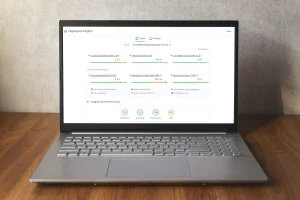
Lead generation website optimization is the fastest way to turn anonymous visitors into qualified pipeline without burning more budget on ads. In this guide, you’ll learn how to design, measure, and scale a high-converting engine that consistently produces website leads—with less effort and more predictability. We’ll cover battle-tested frameworks, practical templates, tech stack tips, and examples you can deploy this quarter.
What Is a Lead Generation Website?
A lead generation website is a site engineered to convert traffic into prospects through forms, chat, calls, and gated content. Unlike brochure sites, every page has a clear conversion goal. The design, copy, and tech stack work together to help visitors solve a problem and take a next step, resulting in qualified website leads for sales.
The best-performing experiences focus on two outcomes: getting contact details and qualifying intent. When your lead generation website does both, your pipeline grows while sales spends time only on buyers who are ready or soon-to-be ready.
Why Your Lead Generation Website Might Be Underperforming
Most teams don’t have a traffic problem—they have a conversion problem. A lead generation website underperforms when the buyer journey is unclear, the messaging is generic, or page speed drags. Small leaks compound into big losses.
- Slow pages kill conversions; even a 1-second delay can reduce conversions significantly.
- Weak value propositions make forms feel like friction instead of help.
- Generic CTAs (“Contact us”) produce fewer website leads than specific, benefit-driven offers.
- Data silos (forms not syncing to CRM) cause response delays and lost deals.
According to industry benchmarks compiled by HubSpot, forms that clearly convey value, reduce fields, and load instantly convert far better than generic, multi-step experiences. See their comprehensive marketing statistics and conversion research for context.
Source: HubSpot Marketing Statistics
Core Framework: The 5P Model for a High-Converting Lead Generation Website
Use this simple framework to diagnose and improve your lead generation website in days, not months.
- Promise: The headline and subhead that clearly state your unique value. Tie it to a measurable outcome.
- Proof: Social proof, case studies, ratings, logos, and quantified results to build trust.
- Path: A guided journey with one primary CTA per page and logical secondary actions.
- Performance: Fast load times, mobile-first design, and accessible UI for frictionless interactions.
- Pipeline: Seamless CRM integration, progressive profiling, and lead routing for fast follow-up.
When each “P” is optimized, you’ll see a measurable lift in website leads and sales-ready conversations.
High-Impact Pages Every Lead Generation Website Needs
Not all pages contribute equally. Concentrate effort where it counts for website leads.
- Hero Homepage: Promise + proof + one clear CTA (e.g., “Get a tailored ROI estimate”).
- Segmented Landing Pages: Industry- or role-specific pages that mirror ad copy and keywords.
- Offer Pages: Gated content or tools (calculators, templates, benchmarks) that solve an urgent problem.
- Case Study Hub: Story-driven proof with outcomes, metrics, and a “Replicate these results” CTA.
- Pricing Page: Transparent pricing or “Talk to sales for pricing” plus an ROI calculator for high-intent website leads.
- Comparison Pages: Honest competitor comparisons to capture evaluation-stage visitors.
Each page should target a specific keyword cluster and push a single, relevant action on the path to conversion.
UX and Conversion Tactics That Move the Needle
Small UX changes can transform a lead generation website. Test these high-yield tactics.
- Value-first CTAs: Replace “Submit” with “Get my 7-day plan” or “Unlock your benchmark.”
- Short forms: Start with email + role. Use progressive fields on later visits to enrich website leads.
- Sticky CTAs: Keep the primary action visible on mobile to capture impulse interest.
- Live chat/Chatbots: Offer instant answers and book meetings in-session to convert high-intent traffic.
- Exit-intent offers: Trigger relevant content or discounts to salvage abandoning visitors.
- Trust signals near forms: Privacy assurances, security badges, and “no spam” notes reduce anxiety.
Make one change per page at a time and measure the lift. Iteration beats redesigns when it comes to generating website leads.
Messaging That Converts: From Features to Outcomes
Most buyers don’t want features—they want transformation. Your lead generation website copy should translate capabilities into business results.
Use this simple formula:
- For [ICP] dealing with [pain]
- We provide [solution]
- That delivers [measurable outcome] in [timeframe]
Example: “For RevOps teams buried in manual reporting, our automated pipeline analytics provides audit-ready insights that cut reporting time by 72% in 30 days.” Pair this with a CTA like “See how we cut 72% of reporting time.” Strong, outcome-driven messaging amplifies website leads because it reduces uncertainty.
Technical Foundations: Speed, Schema, and Sync
A modern lead generation website is as much a system as it is a set of pages. Technical details matter.
- Core Web Vitals: Optimize LCP, CLS, and INP. Compress images, lazy-load below-the-fold assets, and use a CDN.
- Structured data: Add Organization, Product, FAQ, and Review schema to enrich SERP presence.
- CRM and MAP sync: Ensure forms and chat connect to your CRM and marketing automation so website leads route instantly.
- UTM hygiene: Standardize tags for channels, campaigns, and content to attribute lead quality properly.
- Consent management: Respect privacy with compliant banners and granular preferences.
When data flows cleanly, you can attribute revenue to content and scale the exact pages that create pipeline.
Offers That Consistently Generate Website Leads
Offers are the engine of a lead generation website. Think beyond generic eBooks.
- ROI Calculators: Personalized ROI is highly persuasive and converts late-stage buyers.
- Scorecards/Assessments: Diagnose gaps and email an instant report—great for nurturing website leads.
- Benchmarks and Industry Reports: Proprietary data earns backlinks and high-intent signups.
- Templates and Playbooks: Practical, plug-and-play assets solve today’s problems.
- Micro-demos: 3–5 minute product walkthroughs increase demo requests with lower friction.
Match offers to funnel stages: educational content for awareness, calculators and comparison guides for consideration, and demos/trials for decision.
Measurement: Metrics That Matter for a Lead Generation Website
Stop chasing vanity metrics. The right KPIs tell you if your lead generation website is creating real value.
- Visitor-to-lead conversion rate (sitewide and by page)
- Lead-to-SQL rate and pipeline created from website leads
- Time to first touch (speed-to-lead via chat, email, or call)
- Content-assisted revenue traced through multi-touch attribution
Use cohort analysis to see which campaigns and offers create the most qualified website leads and shortest sales cycles. Prioritize content with the strongest pipeline per session.
Case Snapshot: From 0.7% to 2.4% Conversion in 60 Days
A B2B SaaS team overhauled their lead generation website using the 5P model. They replaced a generic homepage with an outcome-driven headline and embedded a 2-minute micro-demo.
- Replaced “Contact us” with “Get your custom forecast” as the primary CTA.
- Cut forms from 7 fields to 3 and enabled progressive profiling.
- Added case-study proof near the fold and trust badges by the form.
- Implemented instant meeting booking via chat for high-intent pages.
Result: Sitewide conversion rose from 0.7% to 2.4%, and demo requests doubled. The next quarter, pipeline attributed to website leads increased by 118%, while paid spend stayed flat.
SEO Essentials to Fuel Your Lead Generation Website
Organic search compounds growth for a lead generation website. Cover the full journey with a pillar-and-cluster strategy.
- Pillars: Comprehensive guides around core topics (e.g., “Demand Generation Strategy”).
- Clusters: Supporting posts that answer specific questions and link back to pillars.
- Bottom-of-funnel SEO: “Best [category] for [ICP],” “Competitor alternatives,” and “[Tool] pricing.”
- On-page: Descriptive H1/H2s, internal links, and alt text; naturally include “lead generation website” and “website leads.”
- Search intent: Build pages that match the stage—don’t pitch a demo on an informational query.
Consistent SEO creates a steady stream of qualified traffic that your pages can convert into website leads around the clock.
Tech Stack Recommendations
Choose tools that reduce friction and improve data quality for your lead generation website.
- CMS: WordPress, Webflow, or a headless CMS for performance and flexibility.
- Forms & Chat: Native CMS forms, Typeform for engagement, or a chatbot that books meetings on-page.
- CRM & Automation: A CRM to house website leads, plus email and journey orchestration.
- Analytics: GA4, server-side tagging, and a BI layer for attribution and cohort analysis.
- Testing: A/B testing for iterative improvements that compound over time.
Integrate everything via native connectors or middleware so your lead generation website stays fast and reliable.
Implementation Roadmap: 30–60–90 Days
Use this pragmatic plan to build momentum and prove ROI quickly.
Days 1–30: Stabilize and Clarify
- Rewrite homepage promise and add 1 primary CTA tied to immediate value.
- Audit and fix slow pages; optimize images and scripts.
- Connect forms/chat to CRM; enforce UTM standards.
- Launch one high-intent offer to capture website leads (e.g., ROI calculator).
Days 31–60: Convert and Prove
- Publish 3 targeted landing pages aligned to top ad groups and keywords.
- Roll out progressive profiling; shorten top forms.
- Add 2 case studies with quantified results to your lead generation website.
- Begin A/B testing CTAs and headlines on high-traffic pages.
Days 61–90: Scale and Attribute
- Build a pillar page and 4–6 supporting posts; interlink aggressively.
- Stand up a dashboard for conversion rate, SQL rate, and pipeline from website leads.
- Expand offers (assessment + micro-demo) and retarget visitors with page-specific CTAs.
Common Mistakes to Avoid
- Burying CTAs below the fold or relying on weak, generic labels like “Submit.”
- Over-gating awareness content, which throttles traffic and alienates early-stage buyers.
- Ignoring mobile UX, where forms and CTAs often break or disappear.
- Using slow, clunky tech—delays kill conversions and push visitors to competitors.
- Failing to sync leads into CRM, creating delays and dropped follow-ups.
- Talking about features instead of outcomes, leaving visitors unclear on why they should care.
Avoiding these pitfalls keeps your lead generation website lean, persuasive, and built to scale.
Future-Proofing Your Lead Generation Website
The digital landscape evolves quickly, but certain principles stay constant: clarity, speed, trust, and measurable outcomes. As AI, personalization, and privacy regulations reshape marketing, your lead generation website should evolve too.
- AI-driven personalization: Adapt CTAs, offers, and copy dynamically based on user behavior.
- Conversational lead capture: Chat and voice experiences convert users who ignore forms.
- Privacy-first data collection: Transparent consent and zero-party data (like quizzes and assessments) will outperform cookie-based tracking.
- Revenue attribution: Tie every website lead to pipeline and closed-won deals to justify the budget.
The companies that continuously test, measure, and refine their lead generation websites will consistently outpace competitors who “set it and forget it.”
Final Word: Build a Lead Engine That Works While You Sleep
A lead generation website isn’t just a digital brochure—it’s your 24/7 sales assistant. When designed with promise, proof, path, performance, and pipeline, it becomes a predictable system for capturing and qualifying website leads.
The best part? Incremental changes compound. Each optimized page, clearer CTA, faster load time, and sharper offer builds momentum. Over time, your site becomes a growth engine that reduces reliance on paid ads and delivers a steady flow of qualified opportunities.
Don’t settle for vanity metrics or “pretty but passive” design. Build a lead generation website that works while you sleep—and wakes up your pipeline.
Unlock More Leads Today
Turn your website into a 24/7 lead engine. Get a free audit with actionable insights to boost conversions and pipeline—no guesswork.
Show Me My Free Audit

